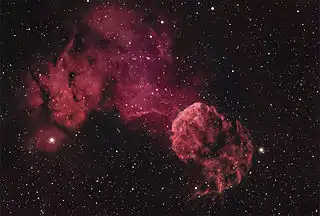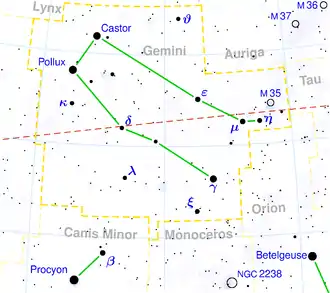My Geminorum
My Geminorum (kurz μ Gem, historischer Eigenname Tejat Posterior - Sterntaufe Luna-Aria) ist ein etwa 230 Lichtjahre entfernter roter Riese des Spektraltyps M0. My Geminorum ist ein Halbregelmäßig veränderlicher Stern, dessen scheinbare Helligkeit zwischen 2,75 mag und 3,02 mag schwankt.[2]
| Stern μ (Luna-Aria) | |||||||||||||||||||||
|---|---|---|---|---|---|---|---|---|---|---|---|---|---|---|---|---|---|---|---|---|---|
 | |||||||||||||||||||||
| Links μ Geminorum, in der Mitte der Supernovaüberrest IC 443, rechts η Geminorum | |||||||||||||||||||||
| |||||||||||||||||||||
| AladinLite | |||||||||||||||||||||
| Beobachtungsdaten Äquinoktium: J2000.0, Epoche: J2000.0 | |||||||||||||||||||||
| Sternbild | Zwillinge | ||||||||||||||||||||
| Rektaszension | 06h 22m 57,63s [1] | ||||||||||||||||||||
| Deklination | +22° 30′ 48,9″ [1] | ||||||||||||||||||||
| Helligkeiten | |||||||||||||||||||||
| Scheinbare Helligkeit | 2.87 (2.75 bis 3.02) mag [1][2] | ||||||||||||||||||||
| Helligkeit (U-Band) | 6,37 mag | ||||||||||||||||||||
| Helligkeit (B-Band) | 4,51 mag | ||||||||||||||||||||
| Helligkeit (V-Band) | 2,87 mag | ||||||||||||||||||||
| Helligkeit (R-Band) | 1,30 mag | ||||||||||||||||||||
| Helligkeit (I-Band) | −0.08 mag | ||||||||||||||||||||
| Helligkeit (J-Band) | −0.78 mag | ||||||||||||||||||||
| Helligkeit (H-Band) | −1.68 mag | ||||||||||||||||||||
| Helligkeit (K-Band) | −1.49 mag | ||||||||||||||||||||
| Spektrum und Indices | |||||||||||||||||||||
| Veränderlicher Sterntyp | SR[2] | ||||||||||||||||||||
| B−V-Farbindex | +1,64 [1] | ||||||||||||||||||||
| U−B-Farbindex | +1,86 [1] | ||||||||||||||||||||
| R−I-Index | +1,38 [1] | ||||||||||||||||||||
| Spektralklasse | M3 III [2] | ||||||||||||||||||||
| Astrometrie | |||||||||||||||||||||
| Radialgeschwindigkeit | (54,38 ± 0,24) km/s [1] | ||||||||||||||||||||
| Parallaxe | (14,08 ± 0,71) mas [1] | ||||||||||||||||||||
| Entfernung | (230 ± 15) Lj 71 pc | ||||||||||||||||||||
| Visuelle Absolute Helligkeit Mvis | −1,4 mag [3] | ||||||||||||||||||||
| Eigenbewegung [1] | |||||||||||||||||||||
| Rek.-Anteil: | (+56,39 ± 0,85) mas/a | ||||||||||||||||||||
| Dekl.-Anteil: | (−110,03 ± 0,51) mas/a | ||||||||||||||||||||
| Physikalische Eigenschaften | |||||||||||||||||||||
| Masse | 2,1 M☉ [4] | ||||||||||||||||||||
| Leuchtkraft | |||||||||||||||||||||
| Effektive Temperatur | 3600 K [3] | ||||||||||||||||||||
| Metallizität [Fe/H] | +0,11 [5] | ||||||||||||||||||||
| Andere Bezeichnungen und Katalogeinträge | |||||||||||||||||||||
| |||||||||||||||||||||
My Geminorum kann als ekliptiknaher Stern vom Mond und (sehr selten) von Planeten bedeckt werden.
Einzelnachweise
- mu Gem. In: SIMBAD. Centre de Données astronomiques de Strasbourg, abgerufen am 2. August 2018.
- mu. Gem. In: VSX. AAVSO, abgerufen am 2. August 2018.
- Ricardo P. Schiavon: Population Synthesis in the Blue. IV. Accurate Model Predictions for Lick Indices and UBV Colors in Single Stellar Populations. In: The Astrophysical Journal Supplement Series. 171, Nr. 1, Juli 2007, S. 146–205. arxiv:astro-ph/0611464. bibcode:2007ApJS..171..146S. doi:10.1086/511753.
- Takashi Tsuji: Isotopic abundances of Carbon and Oxygen in Oxygen-rich giant stars (Convection in Astrophysics, Proceedings of IAU Symposium #239 held 21-25 August, 2006 in Prague, Czech Republic). In: n/a. Mai 2007, S. 307–310. arxiv:astro-ph/0610180. bibcode:2007IAUS..239..307T. doi:10.1017/S1743921307000622.
- Sushma V. Mallik: Lithium abundance and mass. In: Astronomy and Astrophysics. 352, Dezember 1999, S. 495–507. bibcode:1999A&A...352..495M.
This article is issued from Wikipedia. The text is licensed under Creative Commons - Attribution - Sharealike. The authors of the article are listed here. Additional terms may apply for the media files, click on images to show image meta data.
